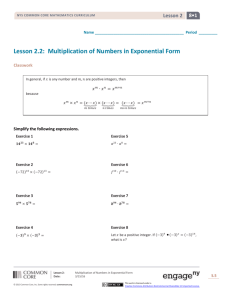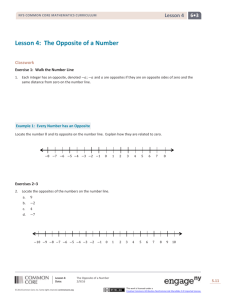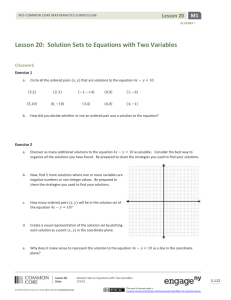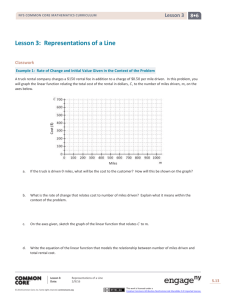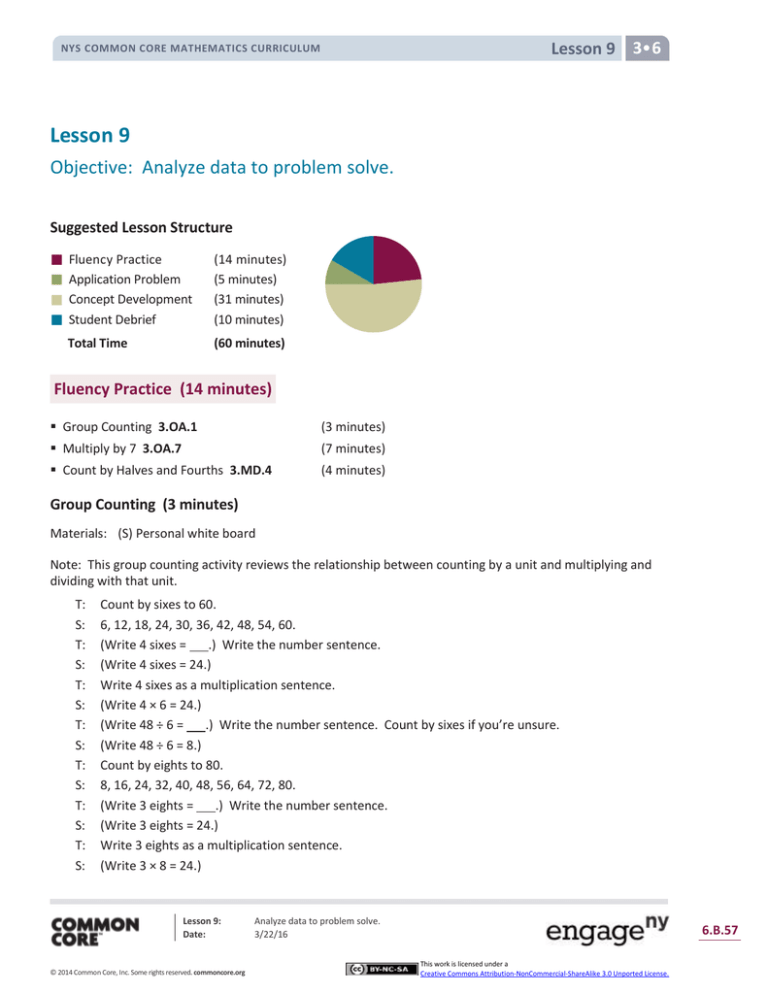
Lesson 9 3•6
NYS COMMON CORE MATHEMATICS CURRICULUM
Lesson 9
Objective: Analyze data to problem solve.
Suggested Lesson Structure
Fluency Practice
Application Problem
Concept Development
Student Debrief
Total Time
(14 minutes)
(5 minutes)
(31 minutes)
(10 minutes)
(60 minutes)
Fluency Practice (14 minutes)
Group Counting 3.OA.1
(3 minutes)
Multiply by 7 3.OA.7
(7 minutes)
Count by Halves and Fourths 3.MD.4
(4 minutes)
Group Counting (3 minutes)
Materials: (S) Personal white board
Note: This group counting activity reviews the relationship between counting by a unit and multiplying and
dividing with that unit.
T:
S:
T:
S:
T:
S:
T:
S:
T:
S:
T:
S:
T:
S:
Count by sixes to 60.
6, 12, 18, 24, 30, 36, 42, 48, 54, 60.
(Write 4 sixes =
.) Write the number sentence.
(Write 4 sixes = 24.)
Write 4 sixes as a multiplication sentence.
(Write 4 × 6 = 24.)
(Write 48 ÷ 6 =
.) Write the number sentence. Count by sixes if you’re unsure.
(Write 48 ÷ 6 = 8.)
Count by eights to 80.
8, 16, 24, 32, 40, 48, 56, 64, 72, 80.
(Write 3 eights =
.) Write the number sentence.
(Write 3 eights = 24.)
Write 3 eights as a multiplication sentence.
(Write 3 × 8 = 24.)
Lesson 9:
Date:
© 2014 Common Core, Inc. Some rights reserved. commoncore.org
Analyze data to problem solve.
3/22/16
6.B.57
This work is licensed under a
Creative Commons Attribution-NonCommercial-ShareAlike 3.0 Unported License.
Lesson 9 3•6
NYS COMMON CORE MATHEMATICS CURRICULUM
T:
S:
T:
S:
T:
S:
T:
S:
T:
S:
(Write 56 ÷ 8 =
.) Write the number sentence. Count by eights if you’re unsure.
(Write 56 ÷ 8 = 7.)
Count by nines to 90.
9, 18, 27, 36, 45, 54, 63, 72, 81, 90.
(Write 4 nines =
.) Write the number sentence.
(Write 4 nines = 36.)
Write 4 nines as a multiplication sentence.
(Write 4 × 9 = 36.)
(Write 54 ÷ 9 =
.) Write the number sentence. Count by nines if you’re unsure.
(Write 54 ÷ 9 = 6.)
Multiply by 7 (7 minutes)
Materials: (S) Multiply by 7 (6–10) (Pattern Sheet)
Note: This activity builds fluency with multiplication facts using units of 7. It works toward students knowing
from memory all products of two one-digit numbers. See Lesson 6 for the directions for administration of a
Multiply-By Pattern Sheet.
T:
S:
T:
S:
(Write 6 × 7 = ____.) Let’s skip-count up by sevens to solve. I’ll raise a finger for each seven. (Raise
a finger for each number to track the count. Record the skip-count answers on the board.)
7, 14, 21, 28, 35, 42.
Let’s skip-count down to find the answer, too. Start at 70. (Count down with fingers as students say
numbers.)
70, 63, 56, 49, 42.
Continue with the following suggested sequence: 8 × 7, 7 × 7, and 9 × 7.
T:
(Distribute the Multiply by 7 Pattern Sheet.) Let’s practice multiplying by 7. Be sure to work left to
right across the page.
Count by Halves and Fourths (4 minutes)
Note: This activity reviews Lesson 6.
T:
S:
T:
Count by halves to 12 halves as I
write. Please don’t count faster
than I can write. (Write as
students count.)
1 half, 2 halves, 3 halves, 4 halves,
5 halves, 6 halves, 7 halves, 8
halves, 9 halves, 10 halves, 11
halves, 12 halves.
2
(Point to 2.) Say 2 halves as a
whole number.
Lesson 9:
Date:
© 2014 Common Core, Inc. Some rights reserved. commoncore.org
Analyze data to problem solve.
3/22/16
6.B.58
This work is licensed under a
Creative Commons Attribution-NonCommercial-ShareAlike 3.0 Unported License.
Lesson 9 3•6
NYS COMMON CORE MATHEMATICS CURRICULUM
S:
1.
T:
(Lightly cross out 2 and write 1 beneath it.)
2
4 6 8 10
,
2
Continue the process for the following sequence: 2, 2, 2,
T:
and
12
.
2
Count by halves, saying whole numbers when you arrive at whole numbers. Try not to look at the
board. (Direct students to count forward and backward on the number line, occasionally changing
directions.)
Repeat the process for fourths.
Application Problem (5 minutes)
Marla creates a line plot with a half-inch scale from 33 to 37 inches. How many tick marks will be on her line
plot?
Note: This problem reviews the concepts taught in Lessons 7─8. Invite students to share their strategies for
solving this problem.
Concept Development (31 minutes)
Materials: (S) Bar graph and line plot (Template)
shown right, personal white board
Template
Problem 1: Solve problems with categorical data.
Project the bar graph from the Template as shown.
T:
This graph shows how some friends spent
their money at the fair.
Project or read the following problem: How much
more money was spent on rides than on parking?
T:
S:
How can you use the graph to help you
solve this problem? Talk to a partner.
I can read the value of the rides bar and
then subtract the value of the parking bar. $35 – $5.
Lesson 9:
Date:
© 2014 Common Core, Inc. Some rights reserved. commoncore.org
Analyze data to problem solve.
3/22/16
6.B.59
This work is licensed under a
Creative Commons Attribution-NonCommercial-ShareAlike 3.0 Unported License.
NYS COMMON CORE MATHEMATICS CURRICULUM
T:
S:
T:
S:
Choose a strategy and solve. (Allow students time to work.) How much more money was spent on
rides than on parking?
$30.
Talk to your partner: Why do you think more money
was spent on rides than on parking?
NOTES ON
The rides are one of the most fun activities at the fair.
MULTIPLE MEANS
Yeah, it wouldn’t make sense if parking cost more
OF REPRESENTATION:
than the rides. If parking was more expensive than
Guide students to use tools within the
the rides, people might not come to the fair at all!
Project or read the following problem: The friends take a total
of $120 to the fair. How much do they have left after the fair?
T:
S:
T:
S:
T:
S:
T:
S:
T:
S:
T:
S:
Lesson 9 3•6
graph to read values. In Money Spent
at the Fair, students should note that
rows are at increments of $10.
Keeping this in mind, guide students to
quickly read the half unit as $5.
Scaffold fluency by having students
draw lines in each bar to make $10
units, connecting back to their reading
of picture graphs.
What is the first thing we need to find out?
We need to find the total amount they spent at the
fair.
Talk to your partner. How will the graph help us find
the total amount?
We can find how much the friends spent on each thing
shown by the bar graph. Then, we can add the
amounts together.
Use the graph to write a number sentence to show how much money the friends spend in all.
(Write $30 + $25 + $5 + $35 = $95.)
How much do the friends spend in all?
$95.
Have we solved the problem?
No. We need to find how much money the friends have left.
Write a number sentence to show how much money the friends have left. (Allow students time to
work.) How much money do they have left after the fair?
$25.
As time allows, continue with the additional questions below. Students may work independently, in pairs, or
in groups.
How much less did the friends spend on rides than on games and food combined?
Parking costs $1 for each hour. The group of friends arrived at the fair at 3:00 p.m. What time did
they leave?
Lesson 9:
Date:
© 2014 Common Core, Inc. Some rights reserved. commoncore.org
Analyze data to problem solve.
3/22/16
6.B.60
This work is licensed under a
Creative Commons Attribution-NonCommercial-ShareAlike 3.0 Unported License.
Lesson 9 3•6
NYS COMMON CORE MATHEMATICS CURRICULUM
Problem 2: Solve problems with measurement data.
Template
Project the line plot from the Template as shown.
T:
This line plot shows the lengths of the crayfish in
Mr. Nye’s third-grade science class.
Project or read the following problem: What is the total
length of all the crayfish that are 3 inches long?
T:
S:
T:
S:
Talk to your partner. How can you use the line plot
to help you solve this problem?
I can skip-count the X’s on the 3-inch mark by three.
I know there are 6 crayfish that are 3 inches long,
so I can just multiply 6 times 3.
Solve. (Allow students time to work.) What is the
total length?
18 inches!
Project or read the following problem: Mrs. Curie’s students also measure the lengths of their crayfish. They
notice the number of crayfish that are less than 3 inches long is half of the number of crayfish that are 3
inches long in Mr. Nye’s class. How many crayfish are less than 3 inches long in Mrs. Curie’s class?
MP.2
T:
S:
T:
S:
T:
S:
T:
S:
T:
S:
What do you need to figure out first to solve this problem?
The number of crayfish in Mr. Nye’s class that are less than 3 inches long.
Discuss with a partner how to find the number of crayfish in Mr. Nye’s class that are less than 3
inches long.
(Discuss.)
How many crayfish are less than 3 inches long in Mr. Nye’s class?
10 crayfish!
How does this help you find the answer to the problem?
Well, Mrs. Curie’s class has half as many, so I can just divide 10 by 2. I know that half of 10 is 5.
How many crayfish are less than 3 inches long in Mrs. Curie’s class?
5 crayfish!
As time allows, continue with the additional questions below. Students may work independently, in pairs, or
in groups.
Ginny uses half-inch square tiles to measure the longest crayfish. How many half-inch square tiles
does she use?
Use the line plot and the chart below to find the total number of crayfish that all of the third-grade
classes are studying.
Classroom
Mr. Franklin
Mrs. Curie
Mr. Nye
Mrs. Nobel
Number of Crayfish
21
23
?
24
The crayfish are kept in small tanks. There are 3 crayfish in each tank. How many tanks does
Mr. Nye’s class need?
Lesson 9:
Date:
© 2014 Common Core, Inc. Some rights reserved. commoncore.org
Analyze data to problem solve.
3/22/16
6.B.61
This work is licensed under a
Creative Commons Attribution-NonCommercial-ShareAlike 3.0 Unported License.
Lesson 9 3•6
NYS COMMON CORE MATHEMATICS CURRICULUM
T:
S:
T:
T:
S:
Data is shown in different forms depending on how it is used. Compare the money spent at the fair
problem to Mr. Nye’s class’s crayfish problem. Talk to your partner. Would it make sense for the
money spent at the fair data to be switched to a line plot? Explain why or why not. Think about how
each representation helps you analyze the data.
Line plots usually show how many times a certain thing happens, like how many crayfish are a
certain measurement. It wouldn’t make sense to try to show money spent at the fair on a line plot.
We use a number line to make a line plot. It wouldn’t make sense to put rides, food, games, and
parking as labels on a number line! What would each X represent?
Bar graphs are used to compare things between different groups, and line plots are used to show
frequency of data along a number line.
Turn and talk to your partner. If we wanted to show the number of coins in 4 piggy banks, what
graph would you use and why?
A bar graph, because we have 4 different groups.
It doesn’t make sense to plot piggy banks on a number line since we’re comparing what’s in each
piggy bank.
If needed and time permits, continue asking students about which graph would be most appropriate for
specific data. The chart below shows some of the titles of bar graphs and line plots they have seen in this
module.
Bar Graphs
Number of fish in each
tank
Number of students in
each class
Amount of money saved
each month
Number of magazines
sold by each student
Line Plots
Lengths of straws
Number of hours spent
outside over the
weekend
Heights of children on
third-grade basketball
team
Lengths of caterpillars
Number of visitors to a
carnival each day
Lengths of plants’ roots
Number of coins in each
piggy bank
Heights of sunflower
plants
Heights of bean plants
Widths of silver maple
tree leaves
Lesson 9:
Date:
© 2014 Common Core, Inc. Some rights reserved. commoncore.org
Analyze data to problem solve.
3/22/16
6.B.62
This work is licensed under a
Creative Commons Attribution-NonCommercial-ShareAlike 3.0 Unported License.
Lesson 9 3•6
NYS COMMON CORE MATHEMATICS CURRICULUM
Problem Set (10 minutes)
Students should do their personal best to complete the
Problem Set within the allotted 10 minutes. For some
classes, it may be appropriate to modify the assignment by
specifying which problems they work on first. Some
problems do not specify a method for solving. Students
should solve these problems using the RDW approach used
for Application Problems.
Student Debrief (10 minutes)
NOTES ON
MULTIPLE MEANS
OF ENGAGEMENT:
Instead of completing the last word
problem of the Problem Set, offer
students working above grade level an
open-ended challenge similar to the
ones listed below:
Represent the information from
Lengths of Blades of Grass in Inches
in a different type of graph. How
does the presentation change your
perception and understanding of
the data?
What other information might you
obtain if you were to make a line
plot for the Number of Apples
Picked picture graph?
Lesson Objective: Analyze data to problem solve.
The Student Debrief is intended to invite reflection and active
processing of the total lesson experience.
Invite students to review their solutions for the Problem Set.
They should check work by comparing answers with a partner
before going over answers as a class. Look for misconceptions
or misunderstandings that can be addressed in the Debrief.
Guide students in a conversation to debrief the Problem Set and
process the lesson.
Any combination of the questions below may be used to
lead the discussion.
What scale did you use for Problem 1(b)? Would
that scale work if Philip picked 21 apples?
Compare your solution for Problem 2(b) to a
partner’s solution. Did you and your partner use
the same strategy to solve the problem?
Explain to your partner how you chose the scale
for the line plot in Problem 3(a).
Other than counting the X’s, is there another
strategy you can use to find the total number of
blades of grass that were measured in Problem
3(b)? (Count the boxes in the chart or multiply to
find the total number of boxes in the chart.)
Would it make sense to display the number of
apples data in a line plot? Why or why not?
When is it best to show your data as a picture
graph? A bar graph? A line plot? What is the
difference?
Lesson 9:
Date:
© 2014 Common Core, Inc. Some rights reserved. commoncore.org
Analyze data to problem solve.
3/22/16
6.B.63
This work is licensed under a
Creative Commons Attribution-NonCommercial-ShareAlike 3.0 Unported License.
NYS COMMON CORE MATHEMATICS CURRICULUM
Lesson 9 3•6
Exit Ticket (3 minutes)
After the Student Debrief, instruct students to complete
the Exit Ticket. A review of their work will help with
assessing students’ understanding of the concepts that
were presented in today’s lesson and planning more
effectively for future lessons. The questions may be read
aloud to the students.
Lesson 9:
Date:
© 2014 Common Core, Inc. Some rights reserved. commoncore.org
Analyze data to problem solve.
3/22/16
6.B.64
This work is licensed under a
Creative Commons Attribution-NonCommercial-ShareAlike 3.0 Unported License.
Lesson 9 Pattern Sheet 3•6
NYS COMMON CORE MATHEMATICS CURRICULUM
Multiply.
multiply by 7 (6–10)
Lesson 9:
Date:
© 2014 Common Core, Inc. Some rights reserved. commoncore.org
Analyze data to problem solve.
3/22/16
6.B.65
This work is licensed under a
Creative Commons Attribution-NonCommercial-ShareAlike 3.0 Unported License.
Lesson 9 Problem Set 3•6
NYS COMMON CORE MATHEMATICS CURRICULUM
Name
Date
1. Four children went apple picking. The chart shows the number of apples children picked.
Name
Number of Apples Picked
Stewart
16
Roxanne
______
Trisha
12
Philip
20
Total:
72
a. Find the number of apples Roxanne picked to complete the chart.
b. Create a picture graph below using the data in the table.
Apples Picked
Number of Apples Picked
= ______ Apples
Child
Lesson 9:
Date:
© 2014 Common Core, Inc. Some rights reserved. commoncore.org
Analyze data to problem solve.
3/22/16
6.B.66
This work is licensed under a
Creative Commons Attribution-NonCommercial-ShareAlike 3.0 Unported License.
Lesson 9 Problem Set 3•6
NYS COMMON CORE MATHEMATICS CURRICULUM
2. Use the chart or graph to answer the following questions.
a. How many more apples did Stewart and Roxanne pick than Philip and Trisha?
b. Trisha and Stewart combine their apples to make apples pies. Each pie takes 7 apples. How many
pies can they make?
1
3. Ms. Pacho’s science class measured the lengths of blades of grass from their school field to the nearest 4
inch. The lengths are shown below.
Lengths of Blades of Grass (in Inches)
2
1
4
2
3
4
2
3
4
3
3
4
2
1
2
3
1
4
2
1
4
3
3
4
3
3
1
4
Lesson 9:
Date:
© 2014 Common Core, Inc. Some rights reserved. commoncore.org
3
1
4
2
3
2
1
2
2
3
4
3
2
1
4
2
3
4
3
1
4
3
3
4
2
3
3
4
1
4
3
2
3
4
Analyze data to problem solve.
3/22/16
6.B.67
This work is licensed under a
Creative Commons Attribution-NonCommercial-ShareAlike 3.0 Unported License.
Lesson 9 Problem Set 3•6
NYS COMMON CORE MATHEMATICS CURRICULUM
a. Make a line plot of the grass data. Explain your choice of scale.
b. How many blades of grass were measured? Explain how you know.
c. What was the length measured most frequently on the line plot? How many blades of grass had this
length?
3
3
d. How many more blades of grass measured 2 4 inches than both 3 4 inches and 2 inches combined?
Lesson 9:
Date:
© 2014 Common Core, Inc. Some rights reserved. commoncore.org
Analyze data to problem solve.
3/22/16
6.B.68
This work is licensed under a
Creative Commons Attribution-NonCommercial-ShareAlike 3.0 Unported License.
Lesson 9 Exit Ticket 3•6
NYS COMMON CORE MATHEMATICS CURRICULUM
Name
Date
Mr. Gallagher’s science class goes bird watching. The picture graph below shows the number of birds the
class observes.
6 Birds
= ______
Number of Birds
Observed
Number of Birds Mr. Gallagher’s Class Observed
Monday
Tuesday
Wednesday
Thursday
Day
a. How many more birds did Mr. Gallagher’s class observe on Wednesday and Thursday than on
Monday and Tuesday?
b. Mr. Manning’s class observed 104 birds. How many more birds did Mr. Gallagher’s class observe?
Lesson 9:
Date:
© 2014 Common Core, Inc. Some rights reserved. commoncore.org
Analyze data to problem solve.
3/22/16
6.B.69
This work is licensed under a
Creative Commons Attribution-NonCommercial-ShareAlike 3.0 Unported License.
Lesson 9 Homework 3•6
NYS COMMON CORE MATHEMATICS CURRICULUM
Name
Date
1. The table below shows the amount of money Danielle saves for four months.
Month
Money Saved
January
$9
February
$18
March
$36
April
$27
Create a picture graph below using the data in the table.
Money Danielle Saves
Money Saved
= ______ Dollars
Month
Lesson 9:
Date:
© 2014 Common Core, Inc. Some rights reserved. commoncore.org
Analyze data to problem solve.
3/22/16
6.B.70
This work is licensed under a
Creative Commons Attribution-NonCommercial-ShareAlike 3.0 Unported License.
NYS COMMON CORE MATHEMATICS CURRICULUM
Lesson 9 Homework 3•6
2. Use the table or graph to answer the following questions.
a. How much money does Danielle save in four months?
b. How much more money does Danielle save in March and April than in January and February?
c. Danielle combines her savings from March and April to buy books for her friends. Each book costs $9.
How many books can she buy?
d. Danielle earns $33 in January. She buys a necklace for $8, and a birthday present for her brother.
She saves the $13 she has left. How much does the birthday present cost?
Lesson 9:
Date:
© 2014 Common Core, Inc. Some rights reserved. commoncore.org
Analyze data to problem solve.
3/22/16
6.B.71
This work is licensed under a
Creative Commons Attribution-NonCommercial-ShareAlike 3.0 Unported License.
Lesson 9 Template 3•6
NYS COMMON CORE MATHEMATICS CURRICULUM
Money Spent at the Fair
$40
Money
Spent
$30
$20
$10
$0
Games
Food
Parking
Rides
Item or Activity
Crayfish Lengths from Mr. Nye’s Class
X
X
X
2
2
𝟏
𝟒
X
X
X
𝟏
2
𝟐
X
X
X
X
𝟑
2
𝟒
X
X
X
X
X
X
X
X
X
3
3
Inches
𝟏
𝟒
X
X
𝟏
3
𝟐
X = 1 Crayfish
bar graph and line plot
Lesson 9:
Date:
© 2014 Common Core, Inc. Some rights reserved. commoncore.org
Analyze data to problem solve.
3/22/16
6.B.72
This work is licensed under a
Creative Commons Attribution-NonCommercial-ShareAlike 3.0 Unported License.


